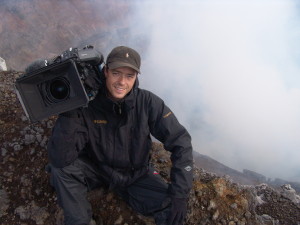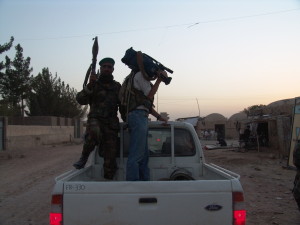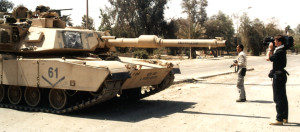The Best Picture Can Change the World
Video journalist/DP/producer Lars Schwetje has developed a mindset honed covering war zones in Bosnia and in Iraq. “I always use my gut instinct and experience to do the right thing in dangerous situations. You lose judgment in fearful situations if fear overpowers you.”
Now based in the United States after his stint in Iraq, Schwetje is director of photography for his own Lars Schwetje Productions, creating video for media companies such as the History Channel, ABC, and NBC, as well as an array of corporate clients.

Lars Schwetje
His assignment for ARD German Television in Baghdad during the first days of the Iraq War in 2003 proved to be his most challenging project. “We crossed frontlines on the third day of war,” he says, “and drove into Baghdad to report from there.”
ARD provided the team with the resources needed for the Iraq assignment, including four satellite uplink modems for transmitting stories and for live mobile stand-ups on the road. They carried several cameras and two laptop-editing computers, as well as helmets and bulletproof vests.
“When we reached the border between Jordan and Iraq, the Iraqi (under the old Saddam regime) border police searched our car.” At that time journalists coming into Iraq were permitted only one satellite phone. “When we got searched the border police screened our camera equipment, food and personal belongings. Our four satellite modems were well hidden within the body of the car.”
Schwetje says one border officer stubbornly continued to search, ready to take their car apart. Just then coalition forces flew over the border crossing and everyone scrambled for cover. “In that moment,” he says, “our search was not that important to the police.” In the confusion, they crossed into Baghdad with all of their equipment intact.
“As a two-man team we shot and sent reports for the main German news shows over the course of 40 days. Each day we filed two separately produced news stories. My correspondent did, on average, two to four live stand ups per day, 10 to 15 radio interviews, and two or three articles per week for major magazines and newspapers.”
For effective reporting in a war zone a TV station will have to provide logistical organization, such as sorting out satellite feeds to file stories, transportation, and getting the right fixers and translators for the stories. Without that kind of support there are no stories.
Capturing the Right Story
Schwetje believes that if you want to capture a story as it unfolds you need to anticipate what’s going to happen next. “Generally all life situations repeat themselves over and over again. For example, if you film in a war zone, a riot or even covering a story with firefighters, it is through those experiences that you get a sense of what may happen next, which will prepare you for the unexpected.”
This attitude – a winning one for any filmmaker or journalist – helps him focus more on filming the story and less on dealing with a changing situation.
“When I worked on my first conflict story during the Bosnian war I was so overwhelmed with the environment itself that I lost sight of capturing good stories.” He says his fear drove his actions because of his lack of experience. “Over the years, experience has helped me block out the environment and focus on the story.”
“I filmed in the hospitals of Baghdad during the 2003 war and seeing wounded people brought into the emergency room was an overwhelming experience, especially when children came in. That day we filmed in the hospital I found myself so shocked by the injuries I saw, I was ready to faint.”
What jolted him back into focus was seeing people dying in front of him, while in the next room a woman gave birth to a boy. “I had to switch gears, put aside my emotions from the ER, and realize that I had to get the story of the woman giving birth to be able to cover life and death in a war.”
In war zone environments Schwetje says bonding with your team is critical. You put your life in their hands. Usually, only people who know each other and have worked together on previous productions – producer, cameraman, editor, soundman, satellite tech – team up to report from war zones.
Trust comes with experience. The person who has the most war reporting background typically leads the team. “Seniority and titles are out of the window when it comes to experience.”
The added challenge, he says, is locating good local stringers, drivers and secure locations to live in. “You often rely on your gut feeling to select a stringer or driver. Trusting these people is often difficult because you don’t know if they work for an insurgency group or if they are spying on you.”
Not knowing what to expect was personally very challenging for Schwetje. How do you plan for reporting from a war zone? “You can and you can’t,” he says. “Taking time well in advance to think about possible scenarios that can happen to you, such as being fired on by any of the conflict forces, or how to deal with government minders and getting footage through the censorship are very important.”
Journalist as Advocate

Schwetje in Afghanistan
“I truly believe it’s important to report from any war or conflict zone. Journalists have an obligation to report the reality (as much as it’s possible to the reporter) from a conflict zone. Atrocities and war crimes often only come to light when journalists cover these events.“
Schwetje firmly believes that “a journalist is an advocate for the people who do not have a voice in war zones.”
Early in his own career Schwetje found the work of Hungarian combat photojournalist Robert Capa a source of inspiration. Capa, who died in 1954 while covering the First Indochina War, is credited with changing the face of wartime photography. Schwetje has adopted Capa’s mantra: “If your picture isn’t good enough, you didn’t get close enough.”
Getting close to a story’s action isn’t easy. Schwetje works at separating personal emotions, controlling them as much as possible, so that he is able to focus on his work and do it better. “I think fear is always there but it can’t dominate you and your work, otherwise you lose sight of your mission. It’s important to respect how dangerous a situation can be, but you always have to be on top of it to make good decisions. If you feel afraid, then you shouldn’t be there.”
He says that in his productions he tries to keep the element of reality a central focus point. “I have always seen myself as an observer of life as it happens and that’s what I try to capture.” He continues, “a camera, whether still or video, is an instrument to capture a moment in time for me. It’s that moment which is important for me to tell the heart of the story.”
Working on Assignment
Schwetje started out as a photojournalist for newspapers and magazines and transitioned into television producing and production management. Camera operators, directors of photography and producers, he says, usually start out as still photographers.
“It’s much easier to get stories printed either in local newspapers or online as a young journalist,” Schwetje says, “but moving into broadcast is much more challenging because jobs in that field are fewer. Transitioning to work on documentaries is extremely difficult because only a very small number of producers and production teams get a chance to work on projects for National Geographic, History Channel, Discovery, and the like.”
Currently he only works on assignment or contract work for clients, organizations and TV networks. “I usually stay away from independent productions.” He learned the hard way if you produce stories yourself it’s very difficult to sell them. TV stations and networks will offer only a portion of what the production is worth. He produced a long-term documentary on international military missions, traveling with the British, U.S., German and other forces worldwide. “In the end it was a good learning experience,” he says, “and I got my story and footage sold, but it’s a hard business selling productions.”
Different Documentary Styles
According to Schwetje, producing for the media in Germany and Europe incorporates more of a situational storytelling, where narration follows the available pictures. In the United States, pictures usually follow script and narration. The U.S. approach allows for a more planned, coordinated, selected way of producing. In productions Schwetje did for the History Channel, for example, images were carefully planned, much more so than those on documentaries for German TV stations. “This, by default, leads to a different approach to storytelling.”

Shooting a tank
“I prefer a mix of both,” Schwetje says. “European story telling is driven by how the situation unfolds. American productions are much more planned and leave more room to design and manage situations by using more tools to tell the story. The DP thus has the ability to focus on the story.”
Schwetje says that when he works on projects, he will take different approaches to tell the story. “Broadcast stories are more witness reports for me. Corporate productions, international organizations, NGOs, and governmental productions are more strategically oriented. We want the viewer to take away a certain message or inform the public about humanitarian aid programs.”
Asked if he thought journalism has changed since he began his career, Schwetje says, “Not really. Journalism is still the same as it was five, 10, or 20 years ago. The real problem is that very few people practice real journalism anymore.
What we see daily on TV is not journalism, it’s infotainment – quickly produced news reports or stories with very little substance.”
Supporting Peace Through Media
“I am working at the moment on a variety of different media projects. Some involve media assistance and capacity-building for war and post-war countries.”
He is convinced that media can be very effective in helping reduce violence and avoid the use of arms by informing the people about peaceful solutions to conflicts, as well as helping with nation-building.
No matter what Schwetje is working on, he brings the same passion he found in himself when he started out as a newspaper/magazine photojournalist 22 years ago. “When I first started taking pictures I realized that I could tell my stories through images and capture reality the way I experienced it. The camera gives me a tool to capture a moment of reality that otherwise passes by and becomes history. I try to keep the moment of reality as current as possible.”
His own truth – “the best picture can change the world.”
